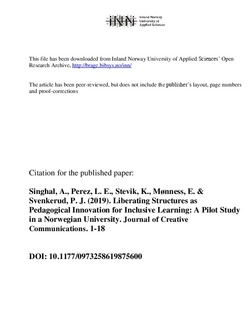Liberating Structures as Pedagogical Innovation for Inclusive Learning: A Pilot Study in a Norwegian University
Journal article, Peer reviewed
Accepted version
Permanent lenke
http://hdl.handle.net/11250/2645362Utgivelsesdato
2019Metadata
Vis full innførselSamlinger
Sammendrag
Liberating Structures (LSs) are simple and concrete tools that can enhance group performance in diverse organizational settings. They do so by organizing participants in different spatial arrangements and group configurations and by distributing participation and sequencing steps. In this article, we report on a pilot implementation of LS in several classrooms of a business school in a mid-sized Norwegian University. Our research is centred around four guiding research questions to gauge students’ experience of LS, including their sense of inclusion, engagement and LS’ pedagogical effectiveness. A mixed-methods approach was employed, including a quantitative survey, participant observation and debriefing conversations and informal interviews with instructors and students who experienced LS. An exploratory survey instrument was employed to measure the various attributes of LS, and four dimensions were identified and validated. Our findings suggest that LS are easy to implement, help increase participation, have the potential to enhance learning and can represent an effective pedagogical alternative to traditional lecture-centred classrooms. Our pilot study suggests that LS hold the creative potency to enhance both the instructor pedagogical experience and the student learning experience. By identifying the limitations of our pilot study, we call for more rigorous assessments of LS in the future.
